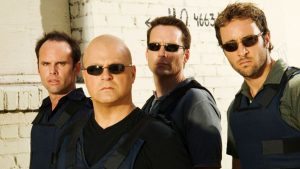A couple of months ago, I wrote about how I could no longer watch reruns of police dramas I once enjoyed, including “NYPD Blue” and its central character, Detective Andy Sipowicz. At a time when voices speaking out against police brutality and racism have taken on a new prominence in America, while the president sends unmarked and unknown armed troops to quell peaceful protests by force, myriad cop shows of the past have become problematic.
One of the TV critics I most admire, Alan Sepinwall, has come to the same conclusion and written his own piece on the subject:
Police dramas have long been my favorite genre of TV storytelling. I was the weird adolescent who videotaped Hill Street Blues reruns when they aired overnight on WPIX in New York; who began recapping NYPD Blue in part because there weren’t a lot of people in my sophomore year of college I could talk with about it; who can recite from memory all the original partner pairings from Homicide: Life on the Street. And right now, revisiting any of them makes me feel complicit. I had a queasy feeling in my stomach as I watched those Hill Street episodes to refresh my memory on the Mike Perez story. I knew going in that some aspects of one of TV’s most groundbreaking and emulated dramas wouldn’t have aged well (the retrograde sexism of many of the characters, a snickering sense of gallows humor), but the show was also much more unabashedly pro-cop than the agnostic message I recalled from watching it in high school. I think of all the Sipowicz head-smacks, all the Raylan Givens [“Justified”] quips and quick-draws that I once applauded, and now cringe at the clichéd notion of the cop who plays by his own rules.
I may be an extreme case in both my past devotion to the form and my current discomfort, but I doubt it. There’s a reason cop stories have been so prominent for so long on the small screen, just as there’s a reason so many people seemed so flummoxed by the vision of real-life American policing that has taken shape during all of the Black Lives Matter protests this year. Surely, we kept saying, these cops must be the exception to the norm, and then these cops also have to be the exception, and these cops and these cops, until the cops whom we thought of as the norm — your straight arrows like Andy Taylor, Joe Friday, and Frank Furillo — start to seem like they are the real exception.
Sepinwall offers more than a new perspective on the anti-hero lead characters of “NYPD Blue” and “The Shield.” He also sees trouble in the rear-view mirror when it comes to a long-revered series centered around a law enforcement figure who always had a good-guy image:
Arguably the most admirable main character TV has ever seen is Andy Taylor from The Andy Griffith Show: a gentle, wise, friendly, superhumanly relaxed man who also happened to be sheriff of a small North Carolina town in the days of Jim Crow. Realizing that segregation would be too complicated and unpleasant a topic for a lighthearted fable of a series, Griffith and the show’s producers chose to sidestep the problem altogether. You might occasionally see a person of color as a background extra in the Mayberry town square, but they were almost never granted speaking parts, given all the questions that might be raised at a moment when other Southern sheriffs were turning dogs and firehoses on black citizens. The evening news provided one harsh image, and then primetime soothed us into thinking that all was well between everyday Americans and the armed men charged with protecting everyone equally, at least in theory, under the law. (Andy’s chief deputy, Barney Fife, is a bumbler who can’t be trusted to keep a bullet in his service weapon and doesn’t know what the Emancipation Proclamation was, but he is presented as a harmless and ultimately well-meaning goof. Brilliant as Don Knotts was in the role, it’s not hard to envision the real Barney Fifes of the day being far more malevolent.)
Read Sepinwall’s full piece here. My original entry on the subject is here.

